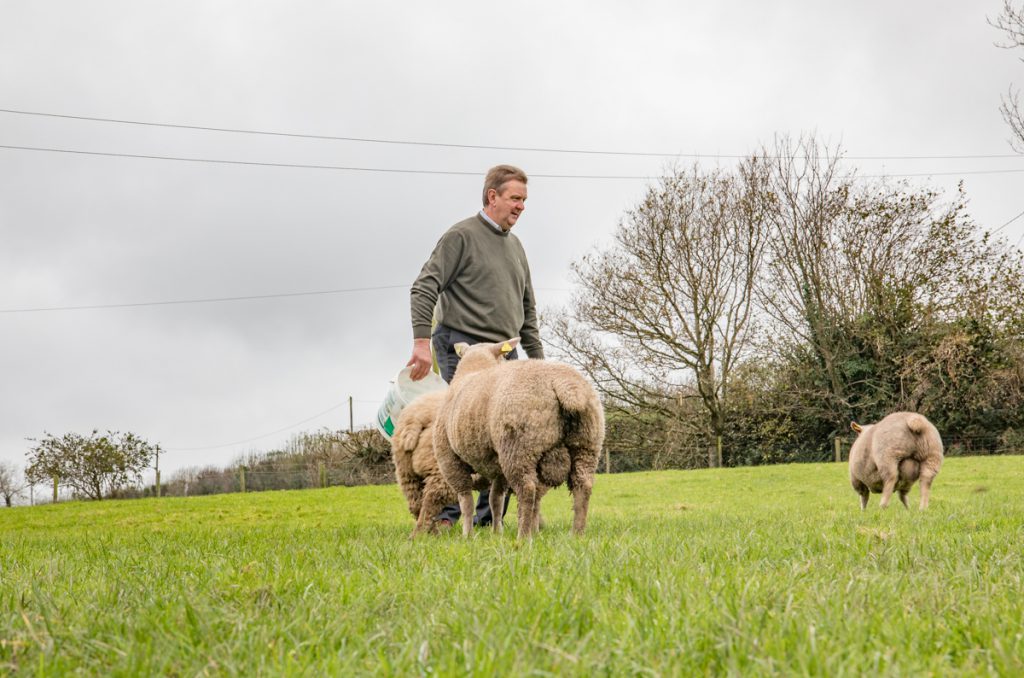On the approach to Albert Ferguson’s ‘Powerview’ Charollais flock in White’s Cross, Co. Cork, one thing becomes truly apparent – you are now entering a stronghold for dairy production in Ireland.
The paddocks leading up to the family farm are still populated with mainly black and white cows; all of which are doing the same job – producing milk, and in turn dairy products, for use in Ireland and further afield.
However, Ferguson’s farm is quite unique, as it’s also home to an award-winning flock of Charollais sheep.
Farming 114ac, 40ac of which are rented, Ferguson has been breeding Charollais sheep for the past 25 years. Like many of his breeding counterparts, the Co. Cork man was first attracted to the breed due to its physical appearance and carcass traits.
As it stands, the Powerview flock consists of 40 pedigree ewes. This enterprise runs in tandem with the farm’s main enterprise of 80 pedigree Holstein Friesian cows; operated under a 50:50 winter/spring calving split.
Ferguson explained: “We have Charollais sheep for 26 years. Originally, we had seen a few of them at shows and thought they would be a great asset to the Irish sheep industry.”
Following on from this interest came the purchase of the flock’s foundation stock in 1991 – a move that shaped and influenced the flock for many years to follow.
Touching on why he chose Charollais, he said: “It comes down to muscle. Also, at birth, lambs are vigorous and stand up and suckle quickly; they are in no way relaxed.
When you’re running a dairy herd, you haven’t much time to be living with them and they need to be able to do their own thing.
Flock foundations
The foundations of the flock – ewes and a ram – were purchased at the Irish Charollais Sheep Society Premier Sale.
This initial purchase included genetics from some of the country’s best-known and regarded flocks. Stock were acquired from the flocks of Rory Brown, Edwin Kelso, James Murphy, Sarah O’Neill and Maeve Upson.
Ferguson’s first stock sire – Cloghala Julius – was purchased from Rory Brown. This ram sired A78 L9, who was Ferguson’s first homebred All-Ireland Champion in 1996. Julius also sired Powerview Plus; a ram which later went on to win the All-Ireland Championship for Melvin Matthews in 1998.
Another ram who also left his mark on the flock was Brittas Pirate. Purchased from Chrisse Murphy, he was the sire of many prize winners including A78 S22 – the Premier Show and Sale Champion in 2004.
Over the years, Ferguson has used AI to breed future generations. This year, the flock was served during the first week of August.
The entire flock were AI’d together and hopefully they will all lamb over five days and nights; kicking off on new year’s day.
As the flock was founded on mainly Irish bloodlines, Ferguson had to look further afield to find suitable stock rams for his flock – a move that sees rams imported from the UK frequently.
“We bring in new bloodlines and we mainly buy our stock rams in England. We use these rams minimally in the first couple of years to make sure they are what we want and they leave the lambs on the ground that we need.”
The move to AI has also allowed the farm to use some of the best Charollais genetics available, including: Netherallan Majestic King; Deerpark Sir; Castellau Ultra; Rockvilla Golden Promise; and Honddu Investigator.
One eye on next spring
Ferguson admitted that he was very happy with the scanning results from his flock, adding: “The ewes scanned at about 1.76 lambs per ewe this year.
We had good conception rates as well and it was up at 87% from AI and that’s very good. We find AI excellent. When you’re running a dairy herd, you haven’t the time to lamb ewes over a spaced-out period.
Although lambing is just six-to-seven weeks away, the Cork-based farmer has yet to begin supplementing his ewes with concentrates.
“When the cows come in, the ewes are let off over all the paddocks and they have lots of grass. We will let the ewes run over the paddocks over the next couple of weeks and put them on concentrates then.”
2017 highlights
Earlier this year, Ferguson was double-handed when he brought to rams to Sheep Ireland’s flagship sale in Tullamore, Co. Offaly.
Now an annual event, the sale is seen by many sheep farmers as the perfect opportunity to acquire some of the top-rated sires – both in terms of the replacement and terminal indices – available in Ireland.
Attracting a big entry of rams from every corner of the country, this year’s sale saw 306 rams catalogued and a clearance rate of 84% – across all breeds entered on the day.
In addition, rams from the flock are sold through society sales and from the farmyard.
“We are breeding them so long now that we have customers that come every other year, or every third year, to purchase a ram.
“Usually, a farmer would come to buy one ram and you think that he would be a goner. However, he’d arrive in two-to-three years time to purchase another two rams.
Annually, Ferguson sells 25-30 rams; if any ram is not up to the mark, he’s culled. “If there’s a ram you can’t stand over yourself, there’s no point and selling him to someone else,” he added.
This move is necessary to ensure that only the best-possible rams are sold from the flock and in order to keep a return customer base. “It’s telling down through the years with repeat customers coming back.”




